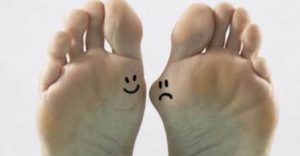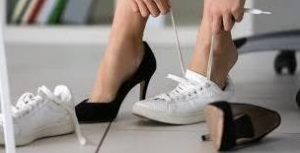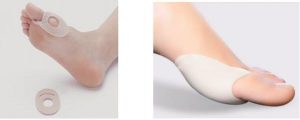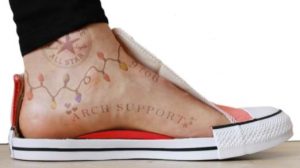A thousand miles begins with a single step. Choosing the right shoes and maintaining the health of the feet can go further. In life, wearing inappropriate shoes can cause hallux valgus, so how to choose shoes?
The heel height of the shoe should be appropriate
The heel of 2~3cm can make the arch of the foot more reasonable so that the buttocks are retracted, the abdomen is tightened, and the chest is straightened, making the person look tall and energetic.
Flat shoes make a person’s center of gravity too far back. When walking, the heel hits the ground, and the vibration can be transmitted to the brain.
An excessively high heel makes the toe metatarsals more difficult and squeezed, which increases the stress on the ankles and knees. The waist and abdomen must be pushed forward to maintain balance, which may easily lead to strain on the muscles and ligaments of the waist and buttocks. Over time, the toes are deformed and often form hallux valgus bunions.
The tightness of the shoes should be appropriate
Shoes that are too tight will squeeze the feet badly, form hallux valgus, corns and calluses appear on the soles of the feet. Loose shoes, feet wandering in the shoes, the shoes do not follow the feet, and the soles of the soles are worn too hard and painful.

Because the thickness of the socks worn in the four seasons is different, the shoes will become looser and larger after wearing them for a long time, and the size of the feet will be different in the daytime, so it is more appropriate to adjust with shoe straps.
Elderly people who have difficulty bending over can wear shoes that can be opened as soon as they are pulled.
It is worth noting that parents must not allow children to wear tight shoes, otherwise the children’s feet will grow deformities. Leave a little space when buying shoes, and change shoes as soon as your feet grow up.
The material of the shoes should be breathable
The breathable material is not only comfortable and does not cover the feet, but also is not easy to get an athlete’s foot. Some shoes are poorly breathable, especially the soles. Although they are strong, the feet sweat easily inside. Cloth shoes are the most breathable, but they are not elegant and not as strong as leather shoes. For people who have to stand for more than 9 hours a day, the feet are the hardest, and a pair of comfortable shoes shouldn’t be better.
Hallux valgus, how to choose shoes?
Once hallux valgus occurs, there will be bony protrusions at the big toe joint on the inside of the foot, often accompanied by pain. They are usually related to the shoes we choose. If you continue to wear the wrong shoes, these protrusions will become larger and more painful. After hallux valgus, what kind of shoes to choose becomes more important.
When the bones that make up your big toe joint deviate from the correct position, a mass will form. This may be related to narrow or pointed shoes squeezing your toes. Hallux valgus can make your big toe stiff and put pressure on your other toes, making it difficult for you to walk. Eventually, this pressure will cause the other toes on that foot to also bend. The swelling and deformed toes of hallux valgus can make you feel more uncomfortable with shoes. In particular, the squeezing of tight or narrow-toed shoes can aggravate the pain of bunions. Wearing the right shoes at this time will not only make your feet more comfortable but also prevent the hallux valgus from further aggravating.
What kind of shoes do I need?
If the hallux valgus is light, a pair of large and comfortable shoes can meet your needs. Shoes should choose a low heel (no more than 5cm) or flat bottom, to give you enough space for your toes. You may need to choose shoes that are at least half a size larger than usual to be comfortable enough. The extra space can not only accommodate calluses or corns on the soles of the feet but also allow space to add insoles that support the soles of the feet.

In addition to buying new shoes, you can also modify existing shoes. The shoe repair shop has a special machine (called the last shoe machine or shoe expander) that can expand and lengthen the shoes so that you can wear them better. You can also wear braces. The insole can reduce the pressure on your feet and make your feet more comfortable.
Features of shoes suitable for hallux valgus
If you have hallux valgus, it is important to find the right shoes. When choosing shoes, always consider function first rather than fashion:
− The shoe should have a wide enough last and a soft sole.
− Buy shoes made of elastic materials, such as leather or canvas.
− There are adjustable shoelaces or Velcro, which can be loosened appropriately according to the size of the foot or bunion.
− Avoid wearing pointed, narrow-toed, or tight-fitting shoes.
− Stay away from high heels higher than 5cm.
Choose other accessories
Once you have the right shoes, add one or more of the following accessories to increase your comfort.
Hallux valgus pad: Place a felt or silicone pad on the hallux valgus protrusion as a buffer. This cushion can prevent your bony prominences from rubbing against your shoes and causing irritation.

Arch support: Some people with hallux valgus usually have flat feet and unstable arches. The arch is the curved area on the sole of your foot, and the arch support insole can help correct this problem.
Thin and loose socks: Don’t wear thick or tight socks. This will put pressure on your bunion and even cause more pain.

Potential Problems
If you continue to wear uncomfortable shoes, the will become bigger. You may also have such complications:
Bunion: The fluid-filled sac is called the bursa, which acts as a buffer between the bones. After the formation of bursitis, it is also called “bunion.”
Hammertoe: The toe is bent at the middle joint, causing pain
The above methods can help you relieve symptoms, but they cannot cure them completely. Once you have hallux valgus, it will not go away unless you have surgery. Therefore, take good care of your feet and choose the right shoes to avoid worsening hallux valgus.
